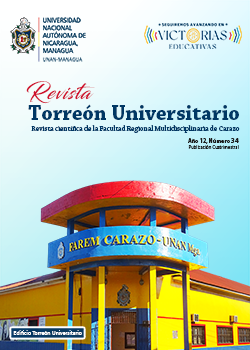Didactic Proposal for The Development of Creativity and Innovation through the subject of Learning, Entrepreneurship and thriving. (LET subject)
DOI:
https://doi.org/10.5377/rtu.v12i34.16338Keywords:
Competencies, Creativity, Didactics, Innovation, Teaching (didactic) ResourcesAbstract
I present this tesis under the title of " Innovation and creativity from the classrooms, which is aimed to create a didactic proposal by competencies to enhance the development of creativity and innovation in a High School Student who is part of Cycle IV of The Learning, Entrepreneurship, Thriving Class (LET).
This tesis was worked out under a mixed philosophical approach, qualitative data collection techniques were utilized (Interviews and checklist) & quantitatives (survey) for a better understanding of the phenomenon that is under study, being this, a descriptive and cross-sectional study.
The results that were obtained allowed to determine what items are missing to foster competencies within the students, such as: team work, ideational fluency, lateral thinking. Currently, there are existing resources in the LET class that could function to develop creativity, however, in it, we're still lacking of pedagogical contextualization and mediation since what's adressed from these venues is more focused towards the conceptual part of them and less from the learning by doing method.
Lastly and referencing the results that were mentioned earlier on this tesis, a didactic I, Creative guide was designed, having the student as the main character of their own learning, this too contains active contextualized strategies, i.e..PBL( Problem based learning ), case studies, simulation, ICT learning and other techniques used to activate creative processes, etc. It's been recommended the use of the didactic guide for the development of the LET lessons adding other certain strategies that could be utilized in other subjects
Downloads
References
Aguilar-Barojas, S. (2005). Fórmulas para el cálculo de la muestra en investigaciones de salud. Salud En Tabasco, 11(1–
, 333–338. https://www.redalyc.org/pdf/487/48711206.pdf
Alaña-Castillo, T. P. (2017). Los recursos didácticos digitales en la calidad del aprendizaje significativo en los
estudiantes de Educación General Básica. Universidad de Holguín Oscar Lucero, 16(2), 112–122. https://ww
w.redalyc.org/articulo.oa?id=589166503012
Barraza Macías, A. (2005). Una conceptualización comprehensiva de la innovación educativa. Instituto Politécnico
Nacional, Distrito Federal, México, 5(28), 19–31. https://www.redalyc.org/pdf/1794/179421470003.pdf
Cáceres Muñoz, J. (2012). La biblioteca escolar un entorno donde desarrollar la creatividad. Camino Del Peral, 8–9.
https://dialnet.unirioja.es/servlet/articulo?codigo=4664877
Cano de Faroh, A. (2007). Cognición en el adolescente según Piaget y Vygotski. ¿ Dos caras de la misma moneda?
Academia Paulista de Psicologia, XXVII(2), 148–166. https://www.redalyc.org/articulo.oa?id=94627214
Clos, I. (2020, April 21). 20 competencias de las personas creativas, más necesarias que nunca. Cultura de Innovación. h
ttps://www.sociedaddelainnovacion.es/20-competencias-personas-creativas/
Collins, M. (2020, abril). 75 fantásticos acertijos de lógica. https://www.navarrosantafe.com/wp-content/uploads/2
/04/acertijos.pdf
Hernández Sampieri, R., Fernández Collado, C., & Baptista Lucio, M. del P. (2014). Metodología de la Investigación
(M. Rocha Martínez, Ed.; Sexta). Mcgraw-HILL / Interamericana Editores, S.A. de C.V.
Suárez, N., Delgado, K., Pérez, I., & Barba, M. (2019). Desarrollo de la Creatividad y el Talento desde las Primeras
Edades. Componentes Curriculares de un Programa de Maestría en Educación. Formación Universitaria, 12(6),
–126. https://www.scielo.cl/scielo.php?script=sci_arttext&pid=S0718-50062019000600115&lng=en&n
rm=iso&tlng=en
Published
How to Cite
Issue
Section
License
Copyright (c) 2023 National Autonomous University of Nicaragua, Managua

This work is licensed under a Creative Commons Attribution-NonCommercial-NoDerivatives 4.0 International License.
The authors who publish in this journal agree to the following terms.
- The author or authors of the articles, essays or research grant the National Autonomous University of Nicaragua, Managua (UNAN-Managua) the editing rights (copyright) of the submitted work, therefore the University has the exclusive right to publish the article for the entire copyright period.
- These copyrights/authors authorize Torreón Universitario Magazine and the University to edit and disseminate/publish the article in said Magazine, including printed and electronic reproduction, storage, retrieval and any other type of publication, and sources of secondary information as services. of summaries and databases, they also empower it to protect the article against unauthorized use for dissemination by printed or electronic media (PDF, HTML, EPUB, XML or others).
License for use of content
The magazine uses the Creative Commons Attribution-NonCommercial-NoDerivs 4.0 International License.
Under this statement:

This journal is licensed under a Creative Commons Attribution-NonCommercial-NoDerivatives 4.0 International License. It can be copied, distributed and transmitted publicly as long as the author and source are cited (Revista Torreón Universitario), it should not be modified or used for any commercial purpose. The full license can be found at http://creativecommons.org/licenses/by-nc-nd/4.0/.



